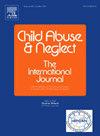Child sexual abuse reporting: Trends and challenges before, during, and after COVID-19 school closures in Georgia, USA
IF 3.4
2区 心理学
Q1 FAMILY STUDIES
引用次数: 0
Abstract
Background
The COVID-19 pandemic led to widespread school closures, raising concerns that reduced contact with mandated reporters would result in underreporting of child sexual abuse (CSA). However, limited empirical research has examined how school closures influenced CSA reporting trends.
Objective
This study investigated whether COVID-19 school closures were associated with varying demographic characteristics of CSA reports in Georgia.
Methods
Data from the National Child Abuse and Neglect Data System (NCANDS) Child File 2019–2021 was used to inform the following research questions in Georgia: 1) What were the demographic characteristics of CSA victims between 2019 and 2021?; 2) Were the COVID-19 school closures associated with the demographic differences (e.g., age, race/ethnicity, gender, socioeconomic circumstances, prior victimization, etc.) in CSA reports?
Results
The findings from this study supported the hypothesis that COVID-19 school closures diminished CSA reporting for some victim groups. The largest proportion of reports involved racial/ethnic minority children (49.9 %), girls (83.0 %), and elementary school-aged children (39.0 %). Prior victimization was noted in 17.2 % of cases, and nearly half of the reports involved children from single-parent households (45.0 %). Proportions of some victim sociodemographic characteristics significantly differed across each of the time periods examined.
Conclusions
COVID-19 school closures led to a decline in CSA reporting for certain victim groups and shifts in victim demographics in Georgia, underscoring the need for future research, policy adaptations, and interventions to address these reporting gaps and ensure more equitable protection for vulnerable children in times of public health emergencies.
求助全文
约1分钟内获得全文
求助全文
来源期刊

Child Abuse & Neglect
Multiple-
CiteScore
7.40
自引率
10.40%
发文量
397
期刊介绍:
Official Publication of the International Society for Prevention of Child Abuse and Neglect. Child Abuse & Neglect The International Journal, provides an international, multidisciplinary forum on all aspects of child abuse and neglect, with special emphasis on prevention and treatment; the scope extends further to all those aspects of life which either favor or hinder child development. While contributions will primarily be from the fields of psychology, psychiatry, social work, medicine, nursing, law enforcement, legislature, education, and anthropology, the Journal encourages the concerned lay individual and child-oriented advocate organizations to contribute.
 求助内容:
求助内容: 应助结果提醒方式:
应助结果提醒方式:


